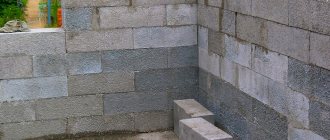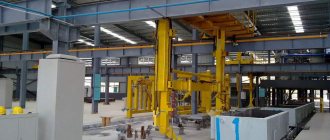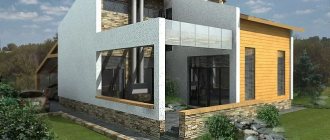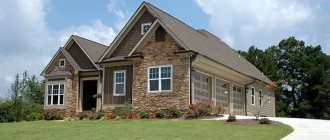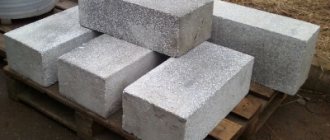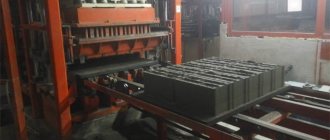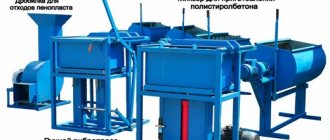Beton-House.com
Website about concrete: construction, characteristics, design. We combine the experience of professionals and private craftsmen in one place
Technological materials in a modern home style
Not everyone and not always have the opportunity to spend large amounts of money on the construction of a reliable and warm residential building. In this case, it is worth paying attention to building materials made from cellular concrete: in addition to good strength, they are also distinguished by their low cost.
Building a house from polystyrene concrete is just one such solution to the problem. We will consider the features of this material, its advantages and disadvantages, as well as examples of some projects in more detail.
- One-story house with an attic floor and an open terrace.
What is polystyrene concrete?
First you need to understand the polystyrene itself - what is it? Polystyrene is a white porous aggregate for concrete mix. It consists of polystyrene granules (PVG).
The proportions of polystyrene concrete, if prepared at home, will be as follows:
- 1 part cement;
- 3 parts sifted sand (you can take regular river sand and sift it);
- 8 parts polystyrene granules.
In production, of course, various fillers are added for strength and other properties of the material.
The basis of polystyrene concrete is expanded polystyrene. Behind this clever name lies the well-known polystyrene foam
Properties and indicators
- density - 150-800 kg/m3;
- frost resistance - 30-150 freeze-thaw cycles;
- thermal conductivity coefficient - 0.055 W/mS-0.145 W/mS;
- compressive strength - B0.35-B2.5;
- flammability - group G1 (non-flammable);
- vapor permeability - 0.05 mg/(m h Pa).
This is, for example, compressive strength. The value is quite low, so it is not recommended to build buildings made of polystyrene concrete with a height of more than two floors. There is a possibility of material deformation.
The next parameter is low vapor permeability. The value is very good for the material. But you can still note the pros and cons of this indicator.
Polystyrene blocks practically do not absorb or allow moisture to pass through, which is why their frost resistance is very good. Unlike aerated blocks, you don’t have to worry about how the material will behave during seasonal rains and snow. But any structure must “breathe,” but buildings made of this material cannot, since steam simply cannot penetrate through it.
I would like to make a separate point about the environmental friendliness of polystyrene concrete. There are many questions for manufacturers here. Laboratory studies and hygienic certificates confirm that this material is environmentally friendly.
However, there is an opinion among a number of skeptics that during operation, styrene gas is released into the air. We would like to provide you with specific data and facts that confirm or refute this, but, alas, there are no such studies in the Russian segment of the construction market.
Density is precisely the parameter that allows you to determine the direction of application of this material. Based on the gradation of application, polystyrene concrete almost completely corresponds to them. Polystyrene concrete blocks with a density of 150–300 kg/m3 belong to the first group; they are usually used for the manufacture of internal, non-load-bearing walls, as well as for exterior finishing of buildings.
The second group includes blocks with a density of 350–500 kg/m3. They are already used for the construction of load-bearing walls inside buildings.
Material with a density of more than 500 kg/m3 belongs to the third group and is called structural. Excellent for laying external low-rise walls of buildings (but no more than two floors, we wrote about this earlier).
In addition to the above, blocks are successfully used for sound and heat insulation of floors, roofs, and ceilings. They are well suited for solving non-standard problems, for example, for reducing the weight of a structure with a “weak” foundation or when constructing some kind of fence (fence).
Pros and cons of houses made of different materials
Let's look at the pros and cons of building houses from different but similar components to decide which material is best.
Pros and cons of a foam block house
Pros of a house made of foam blocks:
- Due to porosity, the walls retain heat well. Therefore, it will not be cold in a house made of foam blocks;
- the house has a pleasant microclimate;
- large block size and relatively light weight. One foam block weighs approximately 23 kg. Therefore, the load on the foundation will be low, which allows you to save money by arranging a simple and inexpensive foundation;
- fire resistance;
- high noise insulation, which is achieved due to the porosity of the material.
Disadvantages of a house made of foam blocks:
- ugly appearance of the building. Exterior finishing required;
- possibility of building shrinkage;
- low bending strength.
Monolithic houses made of polystyrene concrete, pros and cons
There are special building blocks for building houses from polystyrene concrete. But some builders build walls from polystyrene concrete using monolithic technology. To do this, formwork is arranged to suit the size of the wall and filled with polystyrene concrete.
Advantages of monolithic houses:
- fast construction;
- a monolithic house eliminates the possibility of shrinkage;
- not afraid of moisture;
- high strength, which is due to the absence of walls;
- durability. A monolithic house can last up to 120 years if the correct construction technology is followed;
- no point loads are created on the foundation. They are distributed evenly throughout the foundation;
- light weight of the structure, compared, for example, with a brick building;
- All necessary communications can be hidden in a monolithic wall.
Monolithic houses, in general, are stronger than their prefabricated (block) counterparts, but the technology for their execution is difficult for a single self-builder
Disadvantages of monolithic houses:
- pouring monolithic walls requires the use of special construction equipment. Consequently, construction costs increase;
- a monolithic wall must be poured with polystyrene concrete at a time, so you will have to make a large amount of the mixture and have time to work it out quickly.
What supplies and tools will be needed?
To build a bathhouse you will need the following tools:
- hammer;
- order;
- level;
- lace;
- trowel;
- plumb line;
- container for mixing the solution;
- a spatula with teeth or a special container;
- electric drill with attachment.
The list shows the minimum that is needed only for the construction of walls. For foundation work, you will also need a concrete mixer, roofing material, a laser level, a water level, and a square. To equip the roof, you need the material from which the flooring will be made, as well as metal or wooden structures to create a rafter-beam system.
You also need to prepare a cinder block in the required quantity and a solution. The solution used is a cement-sand mixture, which is mixed with water in a concrete mixer or bucket using a drill.
Pros and cons of a house made of polystyrene concrete blocks
This material has many advantages compared to other materials made from cellular concrete. Polystyrene concrete is famous for its availability and ease in the construction of a residential building and any outbuilding.
Standard dimensions of the main factory block made of polystyrene concrete:
- length – 595 mm;
- width: 295 mm;
- height: 375 mm.
One block is quite large; it replaces about 20 ordinary bricks. This increases the speed of building construction.
Advantages of houses made of polystyrene concrete:
- the material is not at all afraid of moisture. On the contrary, he pushes her away;
- the house has an attractive appearance, so external finishing may not be required. In addition, there are special decorative blocks made of polymer concrete, which have a pattern on the outside and are also available in a wide range of colors;
- the material is very light. One block weighs approximately 12-15 kg (depending on the size and composition, because it may be different for each manufacturer). There will be no extra load on the foundation, which allows you to save on its construction;
- the material is fireproof. The only thing is that once the material is exposed to fire, it will lose its strength;
- the walls of the house are not susceptible to attack by rodents and insects;
- You can work with the material in winter, because practically no water is used in the work;
- Building a house from polymer concrete is very easy; even a non-professional can handle it. The blocks are laid on regular polyurethane foam and do not require a thick layer. Thanks to this, you can save on cement mortar;
- high frost resistance - 300 cycles.
The main advantages of expanded polystyrene are its “warmth” and low weight combined with ease of processing
Disadvantages of houses made of polystyrene concrete:
- sudden changes in temperature, together with high humidity, can reduce the service life of a building made of polystyrene concrete;
- If the material is exposed to fire, it may lose its strength. Although the blocks themselves do not burn, during a fire they release a lot of toxic substances;
- Walls need plastering.
It should be noted that the advantages far outweigh the disadvantages. This is why polystyrene concrete has become such a popular material and stands out from similar building materials.
It is also necessary to note that polystyrene concrete is in many ways similar to foam concrete ; for example, these materials have similar advantages.
Production of PSB
Polystyrene concrete is produced industrially and by self-mixing.
Since all the ingredients are affordable and sold in stores without restrictions, homemade production is quite popular in individual construction. To reduce the cost of self-mixed concrete, crushed packaging foam is used instead of granules.
Crushed material has a wide variation in particle size distribution, which makes it difficult to obtain PSB with high strength characteristics.
For do-it-yourself production, the composition and proportions of the mixture components are determined based on the requirements for the density (weight of 1 m3) of the finished material.
“Recipe” for preparing 1 m3 of polystyrene concrete D400:
- cement – 330 kg;
- water – 150 l;
- polystyrene granules – 1 m3;
- foaming agent – 1 kg.
Some home craftsmen manage to make a homogeneous mixture using a shovel in a trough, but professionals recommend using a concrete mixer.
To obtain a homogeneous solution that is not prone to separation, it is necessary to observe the proportions and sequence of loading into the stirrer drum:
- Pour in the granules, add 1/10 of the water and modifiers.
- Mix the contents of the mixer for at least 30 seconds to evenly moisten the polystyrene.
- Add cement.
- Add remaining water and air-entraining additive.
- Stir for 3 – 5 minutes.
The finished solution is loaded into formwork, which is removed after hardening. The material gains its design strength 28 days after pouring. To obtain piece blocks, metal formwork is most often used.
It is also possible to produce a polystyrene concrete mass followed by sawing.
The most popular blocks are the following sizes:
- wall – 150 × 295 (300) × 600, 330 × 295 (300) × 600; 400 × 295 (300) × 600;
- partition – 92 × 600 × 600;
- reinforced lintels – 1300 × 300.
The price of finished PSB in Russia is 3-4 thousand rubles per 1 m3, depending on the brand of density.
Price category
Polystyrene concrete is a very affordable material. There are, of course, building materials that are cheaper, but they are inferior in quality to polystyrene concrete.
Polystyrene concrete blocks, price per piece:
| Block size, HxWxD | Price for 1 piece |
| 138x300x588 mm | 106 rub. |
| 92x300x588 mm | 51 rub. |
| 380x300x588 mm | 282 rub. |
| 188x300x588 mm | 139 rub. |
The price directly depends on the size of the block. Also, pricing is influenced by the composition of polystyrene concrete blocks and the manufacturer . Thus, different manufacturers may have different prices, so the table shows approximate prices, which are not completely accurate.
Knowing the total area of the future house and the price for 1 piece of polystyrene foam concrete block, you can calculate how much it will cost to build the building.
It should be noted that in order to make the construction even more profitable, you can make blocks from polystyrene concrete blocks yourself . Moreover, this process is not too complicated. In addition, you can also lay the blocks yourself, which will save on labor costs.
Walling
There are several ways to make walls from polystyrene concrete. Different products are used for this, so in this chapter we will simultaneously analyze the types of polystyrene concrete products produced.
Block masonry
Polystyrene blocks of different sizes
Blocks for building a house can be purchased ready-made in the store, or you can cast them yourself. And what’s noteworthy is that the quality of the final products will differ little.
Casting polystyrene concrete blocks in molds
It is prepared in the same way as ordinary concrete, and you can easily find the exact recipe on the Internet.
Interesting to know! Polystyrene concrete does not vibrate for compaction, since polystyrene granules begin to float to the surface, disrupting the structure of the product. This fact means only one thing for us – we will work faster.
The laying process proceeds in the following sequence:
- A layer of waterproofing material is laid on the surface of the grillage or plinth. Usually this is roofing felt, which is glued to the base using bitumen mastic. It is best to lay insulation in two layers to ensure the maximum level of protection from moisture, and this must be done even despite the good resistance of polystyrene concrete to water.
Construction of walls - polystyrene concrete
- Next comes the most crucial and difficult moment in all the work - laying the first row. In fact, you are forming a base on which the evenness of all the walls will depend, so you should get a perfectly straight line, leveled.
- The blocks themselves have good geometry and fit perfectly close to each other. So, the task is to make the seams between them as minimal as possible so that cold bridges do not appear, which will be a thick layer of cement-sand mortar.
- To avoid mistakes, they use the lighthouse masonry method, when blocks are placed in the corners on the same level. A fishing line or thread is pulled tightly between them, serving as a guide.
- The base may have uneven surfaces, so the layer of adhesive mixture will constantly change, sometimes reaching several centimeters. For this reason, for the first row we use only cement-sand mortar, the minimum thickness of which should be 1 centimeter.
Walls made of polystyrene concrete blocks - the thinner the seam, the better
- Further laying is usually done using a special adhesive solution. Why not at the TsPS? It's simple - the glue has high elasticity and does not delaminate after mixing. This leads to a reduction in mixture consumption, plus the seams are minimal. The glue layer is easy to control as it is stretched using a comb.
Polystyrene concrete blocks should be laid using special glue
- Another undeniable advantage of the glue is the presence of additives that increase its frost resistance and water resistance.
Advice! If you are worried that glue is very expensive, then just add up the following facts in your mind. Glue consumption is almost two times less than that of DSP. The composition is already completely ready for use, and all that is required of you is to dilute it with water in the required proportions. The glue retains its working properties for several hours, which means you can easily take long breaks. You don't need a concrete mixer for preparation.
How to lay polystyrene concrete blocks - the material can be easily adjusted to the required dimensions
Further work will be no different from laying any other blocks - we raise the walls row by row.
However, there are some points you should always keep in mind:
- We constantly monitor the evenness of each new row. To apply an even layer of glue, we use a special scraper bucket or a toothed grinder - the first option is preferable.
- When laying the blocks, be sure to compact them by lightly tapping them with a rubber mallet.
- Lay out the window and door openings immediately - cutting them out later is highly discouraged.
- The masonry should be reinforced every 4 rows, and the first row should be the starting row.
- To lay the reinforcement in blocks, it is necessary to make grooves along the entire perimeter of the row, which are then cleaned of dust and filled with liquid glue.
Manual wall chaser
- Polystyrene concrete is a rather fragile material, so the grooves are cut with a device like the one in the photo above. This is done very easily and quickly.
In general, reinforcement is a separate topic, but we will tell its basic rules briefly, since we simply cannot fit into the size allotted for the article.
A bathhouse made of expanded polystyrene concrete blocks is also reinforced
- So, we have already said about the first row and every 4 subsequent ones.
- We place reinforcing belts in the places where the lintels of door and cocoon openings support the lintels, while the outlet on the sides should be at least 90 centimeters.
- The last row must also be reinforced - here it is generally better to make a full-fledged armored belt.
Interesting to know! If the block is up to 20 centimeters thick, then the reinforcement is laid in one row - the grooves are made in the center. For wider models, we make two rows, evenly spaced from the center of the block.
A very important point - the rods must bend in the corners and extend onto adjacent walls by at least 50 centimeters, otherwise there will be no normal connection.
Fiberglass reinforcement
Today, many developers prefer to use fiberglass reinforcement, which is corrosion-resistant, lightweight, does not conduct heat, and can withstand bending and tensile loads well. By the way, the last point can be considered an inconvenience, since the part cannot be bent normally and special sleeves are required for turns.
Polystyrene concrete panels
Polystyrene concrete panels
An innovative solution to the use of polystyrene concrete was the production of dimensional wall panels from it.
- These products allow you to build houses in the shortest possible time.
- At the same time, not only walls are made from them, but also floors, roofs and, imagine, stairs (of course, standard ones).
- The panels have the following structure. Inside the polystyrene core there is a metal reinforcing mesh, to which reinforcement rods are welded, extending in all directions.
- The panel is very durable and surprisingly light in weight - the 3*1.2 meter structure weighs about 20 kilograms.
- After the installation of the panels is completed, the core of the products is covered with a concrete shell 5 centimeters thick. Concrete is applied by shotcrete method.
- The result is a monolithic structure only 25 cm thick, comparable in its characteristics (we are talking about thermal insulation) to a brick wall, the thickness of which should be 1.5 meters.
Just think about these numbers! The houses turn out to be very warm and economical, and a sufficiently thick concrete shell will make the material absolutely invulnerable to fire.
Reviews of houses made of polystyrene concrete
Despite the visible advantages of polystyrene concrete, there are very conflicting reviews regarding the advantages and disadvantages of a house made of polystyrene concrete.
It should be understood that homemade PSB blocks will not have the same strength indicators as factory ones
Basically, people praise the accessibility of the material, as well as the ease of working with it . In addition, you can find many positive reviews about the quality properties of the material.
People leave negative reviews mainly out of ignorance. For example, many people write that polystyrene concrete is a flammable material, since polystyrene is nothing more than polystyrene foam, which itself burns. In fact, this is not true. After all, this same foam plastic is enveloped in a concrete mixture. As a result, it will not just light up. Although under the influence of fire the strength of the material may deteriorate.
Density, strength and frost resistance of polystyrene concrete
GOST R 51263-99 standardizes the main performance indicators of polystyrene concrete. According to it, brands are determined by density from D150 to D600, where the number means density in kg/m3. The lower the density, the higher the thermal insulation qualities of the material and the lower its strength.
The standard also defines compressive strength classes from B0.5 to B2.5: the higher the coefficient, the greater the load the block can withstand. Also, compressive strength is sometimes designated by the letter M with a coefficient from 2 to 5. This marking is introduced for a material that is designed without taking into account the requirements of ST SEV 1406, its strength is lower.
Frost resistance is determined by the cycles of freezing and defrosting that the unit can withstand, maintaining its basic performance qualities. For polystyrene concrete, frost resistance ranges from F25 to F100 and increases with increasing material density.
Based on density and a number of indicators that depend on it, polystyrene concrete is divided into three classes:
- Thermal insulating polystyrene concrete with a density of D150-D200 with low strength and low thermal conductivity coefficient (0.055-0.065 W/m*K). Used for insulation of heat-conducting systems, external walls and ceilings;
- Thermal insulating structural polystyrene concrete with a density of D250-D350 can be used for thermal insulation of non-load-bearing and self-supporting walls. In some cases, D350 blocks can even be used for the construction of external load-bearing walls, provided that the building is low-rise and the external cladding is light;
- Structural thermal insulating polystyrene concrete grades D400-D700 are used for the construction of load-bearing walls of low-rise buildings (up to 3 floors) and non-load-bearing walls of multi-storey buildings. Monolithic buildings are also erected from polystyrene concrete of these brands.
Areas of application
The areas of use of PSB blocks depend on the density of the material:
In classical construction. Structural products are used for the construction of main walls and partitions. There are ordinary and reinforced (reinforced) PSB blocks.
PSB facing blocksSource isd-group.ru
- In monolithic construction (as thermal insulation). The material is used both in the form of blocks and in liquid form. The mixture is prepared directly on site and is used for screeding floors, insulating roofs, pouring floors, and filling frames. It is also used as fireproof coatings.
- As a finishing material. We produce PSB masonry blocks with a decorative front side (with cladding) and finishing panels for façade cladding.
- As thermal insulation (insulation). Low density thermal insulation boards are produced.
- During the construction of chimneys and ventilation ducts.
About the crash test of polystyrene concrete and aerated concrete in the following video:
How to build: step by step
Foundation
To build a house from polystyrene concrete with your own hands, it is important to thoroughly study the stages of construction and not deviate from them. First of all, the foundation of the building is erected, taking into account the density and characteristics of the soil.
When choosing a strip foundation, you will need to dig trenches, the bottom of which should be filled with sand and coarse crushed stone. The height of the constructed foundation above the ground is up to 70 cm.
Walls and roof
Before erecting wall elements, reinforcement mesh is laid. Next, install the blocks, leaving a seam of no more than 0.8 cm, and check the evenness with a building level. Polystyrene concrete blocks are fixed with special glue or mortar. The walls of a polystyrene concrete house can also be made monolithic using removable formwork. In this case, the solution is poured from the corners of the structure where the reinforcement is installed and no additional insulation is provided.
Next, ceilings are installed and a metal channel is used over wide openings, and small door or window openings are formed using reinforced self-supporting lintels. Usually, for a house made of PB blocks, bituminous shingles are chosen, which are laid on pre-laid waterproof plywood. This type of roofing has an optimal price-quality ratio, is lightweight, easy to install, reliable and durable.
The walls of the structure can be made using the monolithic method.
After the walls have been forced out, the roof of the building is formed.
Finishing and insulation
At the last stage of construction, finishing work is carried out. For finishing, decorative plaster or hollow red brick is used, which is attached to a polystyrene concrete wall using a cement-sand mixture. To save on cladding, experienced developers recommend immediately using textured PB blocks. Since such building material has excellent thermal insulation properties, additional insulation of the house is usually not required.
Be carefull!
Particularly worth mentioning is the environmental cleanliness
polystyrene concrete.
Since this is a composite made using chemical components, it would be more correct to talk about its radiation and sanitary safety, which must be confirmed by appropriate product certificates. Moreover, it must be taken into account that although the material is classified as low-flammable and difficult to ignite, when exposed to high temperatures for a long time, processes of structural destruction begin in it, accompanied by gas release. This means that, being neutral under normal operating conditions, in the event of a fire polystyrene concrete will manifest itself as a source of toxic volatile compounds (group T2 - moderately hazardous).
In addition, it would be logical to question the hundred-year service life of the material claimed by the manufacturers. The fact is that in addition to high-temperature destruction, there is also a natural one, which occurs due to aging under the influence of the external environment (oxygen in the air, light, heat), mechanical stress, etc.
Its course can be aggravated and accelerated by violations of technology in the manufacture of blocks, the use of installation, repair or finishing compounds that are incompatible with them, as well as other factors. As a result, the material gradually breaks down at the molecular level, changing its thermophysical properties. So there is no need to talk about the century-long “life expectancy” of polystyrene concrete.
Plastering allows you to protect the material from the influence of external factors, but the problem is that it has poor adhesion to the solution,
therefore, the surfaces must first be treated with compounds that improve the adhesion of the finishing layer to the base. Cladding walls (with siding, clapboard or using a ventilated facade system) is also fraught with difficulties: polystyrene concrete does not hold conventional fastening elements well, which is why it is necessary to use specialized butterfly dowels, nylon expansion or chemical anchors to create a substructure. The same feature of the material must be taken into account when installing window and door frames in the house, and when fixing heavy objects (radiators, wall cabinets, mirrors) on the walls, calculate pull-out loads.
| Index | Brick | Expanded clay concrete | Aerated concrete | Foam concrete | Polystyrene concrete |
| Density, kg/m³ | 1400–1700 | 600–1800 | 300–1200 | 300–1200 | 150–600 |
| Thermal conductivity, W/m‧°С | 0,45–0,7 | 0,14–0,65 | 0,11–0,16 | 0,12–0,35 | 0,05–0,14 |
| Strength, kgf/cm² | 75–250 | 35–150 | 20–35 | 12–70 | 5,2–36,7 |
| Water absorption, % mass | 6–12 | 18 | 25 | 10–16 | 4 |
| Frost resistance, cycles | 15–35 | 25–50 | 25–35 | 25–35 | 25–100 |
| Wall thickness with the same thermal conductivity, m | 1,2 | 0,8 | 0,3 | 0,4 | 0,3–0,4 |
We recommend reading:
How to correctly measure the area of rooms and premises? What tools are needed?
Didn't find an article on a topic that interests you?
Just write a few words in the form at the top of the screen, our search will automatically select suitable articles.
Partner news: All about country life and construction
Where is Moscow expanding? And what does this mean for summer residents? 586522 Will the Central Ring Road be able to relieve congestion on highways near Moscow? 328461 How to calculate acres of land? 272478 Which areas of the Moscow region are the cleanest and dirtiest in terms of ecology? 234517 Which metro stations will be built in the Moscow region? 210016
How much does it cost to connect a house and land to communications? 157596 Where is it better to live in the Moscow region? Rating of districts 127119 How many acres of land do you need to build a house? 124603 Districts of New Moscow. What are their advantages and disadvantages? 122332 What are the restrictions on construction near rivers and reservoirs? 106600 Which home heating is more profitable: gas or electric? 91610 Building codes and rules for the development of land plots 87137 What exhibitions of finished houses are there in Moscow and the Moscow region? 82492 The best cottage villages in the Moscow region 74987 What houses are currently on sale in the Moscow region? 71058 What are land plots without a contract? 63403 Are the basement and basement considered floors? 59357 Land development from scratch. Where to begin? 56364 Is it possible to leave SNT? 55216 What taxes must be paid for a house, garage, bathhouse and other buildings? 53086 How to re-register a plot? And how much does it cost? 54453 Is it profitable to build a house for sale? 49722 Where will the gas soon be? Gasification plan for villages in the Moscow region 46956 The best places for fishing in the Moscow region 45577 Pitfalls when buying a house
What should you pay attention to? 44219 How to bargain for a house? 43096 Life in a cottage community. Pros and cons 43039 Rating of Moscow region districts by quality of life 46061 Is it worth buying a house in SNT for permanent residence? 45718 Do I need to obtain permission to build a house on my site? 44080 Will a house built in SNT be considered residential? 42271 What to do after purchasing a plot? 38802 How long does it take to build private houses? 36443 The largest and most expensive cottages in Russia 35652 How much will it cost to build your own house? 34879
What is the best material to build a house for permanent residence from? 31842 How to register a rented plot under a house? 31209 Is it worth renting forest land for construction? 29013 How many floors can a cottage be built on? 28775 Ecovillages and ecovillages. What it is? 27789 What is the size of utility bills in cottage villages? 26705 How to build a house on a plot with a slope? 26152 Repair and decoration of a cottage. Work order and all stages 25583 Purchase of a plot with an unregistered house. What are the risks? 24136 Which private houses are warmer in winter? 23893 Division of a house with a plot. How to apply correctly? 23048 Gas to a private house. How to do it? 23048 How to rent out your plot? 22473 Turnkey house construction? Like this? And how much will it cost? 21681 Depreciation of the condition of the house. How to understand? How to calculate? 21108 Modular houses. What it is? 20520 How much will it cost to maintain your home? 20195 Lands of private household plots. What are their pros and cons? 19822 Forest areas (near the forest). What are their pros and cons? 19260 How to change the purpose of a site? 19127 Which is better: Cottage or Townhouse? 18830 Is it possible to turn a dacha into a residential building? 18564
